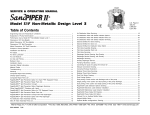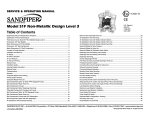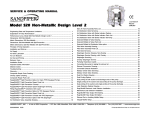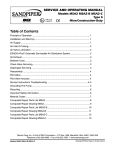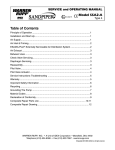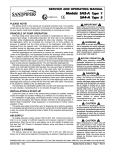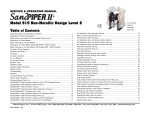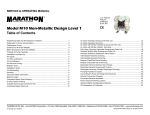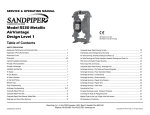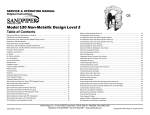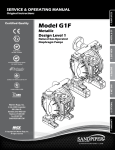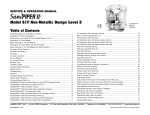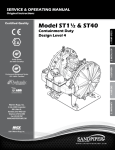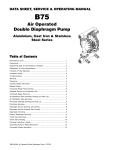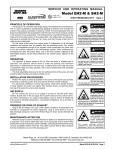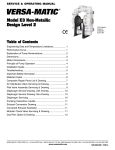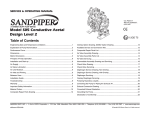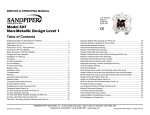Download Service Manual - Amalgamated Pumping Supplies
Transcript
SERVICE & OPERATING MANUAL ® Model S1F Non-Metallic Design Level 3 CE U.S. Patent # 400,210 5,996,627 6,241,487 Table of Contents Engineering Data and Temperature Limitations ............................................................................ 1 Explanation of Pump Nomenclature .............................................................................................. 2 Performance Curve, Model S1F Non-Metallic Design Level 3 ...................................................... 3 Dimensions: S1F Non-Metallic ........................................................................................................ 4 Metric Dimensions: S1F Non-Metallic ............................................................................................. 5 Dimensions: S1F Spill Prevention .................................................................................................. 6 Metric Dimensions: S1F Spill Prevention ........................................................................................ 7 Principle of Pump Operation ........................................................................................................... 8 Installation and Start-up ................................................................................................................. 8 Air Supply ........................................................................................................................................ 8 Air Valve Lubrication ....................................................................................................................... 8 Air Line Moisture .............................................................................................................................. 8 Air Inlet and Priming ........................................................................................................................ 8 Between Uses ................................................................................................................................. 8 Installation Guide ............................................................................................................................ 9 Important Safety Information ........................................................................................................ 10 Material Codes .............................................................................................................................. 10 Troubleshooting ............................................................................................................................. 11 Warranty ........................................................................................................................................ 11 Composite Repair Parts Drawing .................................................................................................. 12 Overlay Option Drawing ................................................................................................................ 12 Composite Repair Parts List ......................................................................................................... 13 RuppGUARD™ Spill Prevention Option for Virgin PTFE Equipped Pumps ............................... 14 RuppGUARD™ Spill Prevention Repair Parts List ....................................................................... 14 RuppGUARD™ Spill Prevention Concept .................................................................................... 15 RuppGUARD™ Spill Prevention Option Diaphragm Servicing .................................................... 15 Filling RuppGUARD™ Chambers with Liquid ............................................................................... 15 RuppGUARD™ Spill Prevention Option for TPE Equipped Pumps ............................................ 16 RuppGUARD™ Spill Prevention Repair Parts List ....................................................................... 16 RuppGUARD™ Spill Prevention Concept with TPE Diaphragms ............................................... 17 RuppGUARD™ Spill Prevention Option with TPE Diaphragm .................................................... 17 Air Distribution Valve Assembly Drawing ...................................................................................... 18 Main Air Valve Assembly Parts List ............................................................................................... Air Distribution Valve Servicing ..................................................................................................... Air Distribution Valve with Stroke Indicator Options ..................................................................... Air Distribution Valve with Stroke Indicator Parts List .................................................................. Air Distribution Valve with Stroke Indicator Servicing ................................................................... Pilot Valve Servicing, Assembly Drawing & Parts List .................................................................. Solenoid Shifted Air Valve Drawing .............................................................................................. Solenoid Shifted Air Valve List ..................................................................................................... Solenoid Shifted Air Distibution Valve Option .............................................................................. Diaphragm Service Drawing, Non-Overlay ................................................................................... Diaphragm Service Drawing, with Overlay .................................................................................... Diaphragm Servicing ..................................................................................................................... Overlay Diaphragm Service .......................................................................................................... Pumping Hazardous Liquids ......................................................................................................... Converting the pump for piping the exhaust air .......................................................................... Exhaust Conversion Drawing ........................................................................................................ Converted Exhaust Illustration ..................................................................................................... Modular Check Valve Servicing .................................................................................................... Modular Check Valve Drawing ...................................................................................................... Dual Port Option Drawing ............................................................................................................. Dual Porting Options ..................................................................................................................... Dual porting of both suction and discharge ends of the pump .................................................. Single porting of the suction and dual porting of the pump discharge ...................................... Dual porting of the suction and single porting of the pump discharge ....................................... RuppTech® Leak Detection Options Drawing ............................................................................. RuppTech® Electronic Leak Detector Installation ....................................................................... RuppTech® Mechanical Leak Detector Installation ..................................................................... RuppTech® Pulse Output Kit Drawing ......................................................................................... RuppTech® Pulse Output Kit Option ........................................................................................... Exhaust Port or Auxiliary Muffler Setup ....................................................................................... Integral Muffler Setup ................................................................................................................... Optional Muffler configurations, Drawing ..................................................................................... 18 19 20 20 21 22 23 23 24 25 25 26 26 27 27 27 27 28 28 29 30 30 30 30 31 31 31 32 32 32 32 33 Warren Rupp, Inc. • A Unit of IDEX Corporation • P.O. Box 1568, Mansfield, Ohio 44901-1568 USA • Tel: (419) 524-8388 • Fax (419) 522- 7867 • www.warrenrupp.com 520-199-000 1/05 ® U.S. Patent # 5,996,627; 400,210; 6,241,487 Other U.S. Patents Applied for Quality System ISO9001 Certified Environmental Management System ISO14001 Certified S1F NonMetallic Non-Metallic Design Level 3 Ball V alve Valve Air-Powered Double-Diaphragm Pump CE ENGINEERING, PERFORMANCE & CONSTRUCTION DATA INTAKE/DISCHARGE PIPE SIZE CAPACITY AIR VALVE SOLIDS-HANDLING HEADS UP TO DISPLACEMENT/STROKE 1" ANSI Flange or PN10 25mm DIN Flange 0 to 45 gallons per minute (0 to 170 liters per minute) No-lube, no-stall design Up to .25 in. (6mm) 100 psi or 231 ft. of water (7 bar or 70 meters) .17 gallon / .64 liter CAUTION! Operating temperature limitations are as follows: Operating Temperatures Maximum* Minimum* Materials Santoprene®: Injection molded thermoplastic elastomer with no fabric layer. Long mechanical flex life. Excellent abrasion 275°F 135°C -40°F -40°C alkali metals, turbulent liquid or gaseous fluorine and a few fluoro-chemicals such as chlorine trifluoride or oxygen difluoride which readily liberate free fluorine at elevated temperatures. 220°F 104°C -35°F -37°C PVDF 180°F 82°C -35°F -37°C Polypropylene 180°F 82°C 32°F 0°C resistance. Virgin PTFE: Chemically inert, virtually impervious. Very few chemicals are known to react chemically with PTFE: molten Buna N: General purpose, oil-resistant. Shows good solvent, oil, water and hydraulic fluid resistance. Should not be used with highly polar solvents like acetone and MEK, ozone, chlorinated hydrocarbons and nitro hyrdrocarbons. 190°F 88°C -10°F -23°C Neoprene: All purpose. Resistant to vegetable oil. Generally not affected by moderate chemicals, fats, greases and many oils and solvents. Generally attacked by strong oxidizing acids, ketones, esters, nitro hydrocarbons and chlorinated aromatic hydrocarbons. 200°F 93°C -10°F -23°C Viton®: Shows good resistance to a wide range of oils and solvents; especially all aliphatic, aromatic and halogenated 350°F 177°C -40°F -40°C hydrocarbons, acids, animal and vegetable oils. Hot water or hot aqueous solutions (over 70°F) will attack Viton. For specific applications, always consult the Warren Rupp “Chemical Resistance Chart” SANDPIPER® pumps are designed to be powered only by compressed air. 520-199-000 1/05 Model S1F Non-Metallic Design Level 3 Page 1 Explanation of Pump Nomenclature S1F Non-Metallic · Design Level 3 · Ball Valve Model Pump Pump Brand Size S1FB3P1PPUS000. S1FB3P2PPUS000. S1FB3PBPPUS000. S1FB3PGPPUS000. S1FB3PNPPUS000. S1FB3PVPPUS000. S1FB3K1KPUS000. S1FB3K2KPUS000. S1FB3P3PPUV000. S1FB3K3KPUV000. S1FB3P4PPUV000. S1FB3K4KPUV000. S S S S S S S S S S S S 1F 1F 1F 1F 1F 1F 1F 1F 1F 1F 1F 1F Pump Brand S= SANDPIPER® Pump Size 1F= 1" Full Flow Check Valve Type B= Ball Design Level 3= Design Level 3 Wetted Material K= PVDF P= Polypropylene Diaphragm Check Valve Materials 1= Santoprene/Santoprene 2= PTFESantoprene Backup/PTFE 3= PTFE Pumping, PTFE-Santoprene Backup Driver/PTFE 4= Santoprene Pumping/Santoprene B= Buna/Buna G= PTFE-Neoprene Backup/PTFE N= Neoprene/Neoprene V= Viton/Viton 520-199-000 1/05 Check Valve Type Design Level Wetted Material Diaphragm/ Check Valve Materials Check Valve Seat B B B B B B B B B B B B 3 3 3 3 3 3 3 3 3 3 3 3 P P P P P P K K P K P K 1 2 B G N V 1 2 3 3 4 4 P P P P P P K K P K P K Non-Wetted Material Porting Options Options P P P P P P P P P P P P Check Valve Seat K= PVDF P= Polypropylene S= Standard V= RuppGUARD™ with Visual Leak Detection Non-Wetted Material Options P= Polypropylene X= Unpainted Aluminum 1= 40% Glass Filled Polypropylene with PTFE hardware Porting Options U= Universal (Fits ANSI and DIN) 7= Dual Porting (ANSI) 8= Top Dual Porting (ANSI) 9= Bottom Dual Porting (ANSI) Pump Options 0= None 1= Sound Dampening Muffler 2= Mesh Muffler 3= High temperature Air Valve w/Encapsulated Muffler 4= High temperature Air Valve w/Sound Dampening Muffler 5= High temperature Air Valve w/Mesh Muffler Pump Style D= RuppGUARD™ with Electronic Leak Detection (110V) E= RuppGUARD™ with Electronic Leak Detection (220V) M= RuppGUARD™ with Mechanical Leak Detection Kit Options 00.= None P0.= 0-30VDC Pulse Output Kit P1.= Intrinsically-Safe 10-30VDC Pulse Output Kit P2.= 110/120 or 220/240VAC Pulse Output Kit U U U U U U U U U U U U Pump Style S S S S S S S S V V V V Pump Kit Options Options 0 0 0 0 0 0 0 0 0 0 0 0 00. 00. 00. 00. 00. 00. 00. 00. 00. 00. 00. 00. Shipping Weight lbs. (kg) 42 (19) 42 (19) 42 (19) 42 (19) 42 (19) 42 (19) 54 (24) 54 (24) 48 (22) 64 (29) 48 (22) 64 (29) P3.= Intrinsically-Safe 110/120VAC Pulse Output Kit P4.= Intrinsically-Safe 220/240VAC Pulse Output Kit E0.= Solenoid Kit with 24VDC Coil E1.= Solenoid Kit with 24VDC Explosion-Proof Coil E2.= Solenoid Kit with 24VAC/ 12VDC Coil E3.= Solenoid Kit with 24VAC 12VDC Explosion-Proof Coil E4.= Solenoid Kit with 110VAC Coil E5.= Solenoid Kit with 110VAC Explosion-Proof Coil E6.= Solenoid Kit with 220VAC Coil E7.= Solenoid Kit with 220VAC Explosion-Proof Coil SP.= Stroke Indicator Pins Model S1F Non-Metallic Design Level 3 Page 2 MODEL S1F Non-Metallic Performance Curve 5 (8.5) 10 (17) 7 100 1 00 P SI ( 6 .8 90 6 80 70 60 2 44 B ar) 35 (59.5) 40 (68) 8 Ba 40 40 PS I 30 20 PS 1 10 0 0 (2.72 I (1.36 5 30 25 20 15 10 5 9.7 7.6 6 4.5 3 1.5 r) 45 (76.5) 20 0 30 (51) 60 P SI (4 .0 50 3 25 (42.5) METERS 4 I (5. 20 (34) Bar ) FEET HEAD 5 80 P S Performance based on water at ambient temperature. 15 (25.5) NPSHR PSI BAR Performance Curve, Model S1F Non-Metallic Design Level 3 Bar) Bar) A ir Inlet 10 Pressu re 15 20 25 30 35 40 45 50 55 U.S. Gallons per minute 0 10 20 30 40 50 60 70 80 90 100 110 120 130 140 150 160 170 180 190 200 Liters per minute CAPACITY 520-199-000 1/05 Model S1F Non-Metallic Design Level 3 Page 3 Dimensions: S1F Non-Metallic Dimensions in Inches Dimensional tolerance: ±1/8" DIMENSION Standard Pump Pulse Output Kit Mesh Muffler Sound Dampening Muffler 520-199-000 1/05 A 5 5/8" 7 3/8" 8 9/16" 8 9/16" B 10 1/4" 12" 11 5/32" 11 5/32" Model S1F Non-Metallic Design Level 3 Page 4 Metric Dimensions: S1F Non-Metallic Dimensions in Millimeters Dimensional tolerance: ±3mm DIMENSION Standard Pump Pulse Output Kit Mesh Muffler Sound Dampening Muffler 520-199-000 1/05 A 143mm 187mm 167mm 167mm B 260mm 305mm 283mm 283mm Model S1F Non-Metallic Design Level 3 Page 5 Dimensions: S1F Non-Metallic with RuppGUARD™ Spill Prevention Dimensions in Inches Dimensional tolerance: ±1/8" DIMENSION Standard Pump Pulse Output Kit Mesh Muffler Sound Dampening Muffler 520-199-000 1/05 A 5 5/8" 7 3/8" 8 9/16" 8 9/16" B 10 1/4" 12" 11 1/8" 11 1/8" Model S1F Non-Metallic Design Level 3 Page 6 Metric Dimensions: S1F Non-Metallic with RuppGUARD™ Spill Prevention Dimensions in Millimeters Dimensional tolerance: ±3mm DIMENSION Standard Pump Pulse Output Kit Mesh Muffler Sound Dampening Muffler 520-199-000 1/05 A 143mm 187mm 167mm 167mm B 260mm 305mm 283mm 283mm Model S1F Non-Metallic Design Level 3 Page 7 PRINCIPLE OF PUMP OPERATION This ball type check valve pump is powered by compressed air and is a 1:1 ratio design. The inner side of one diaphragm chamber is alternately pressurized while simultaneously exhausting the other inner chamber. This causes the diaphragms, which are connected by a common rod secured by plates to the centers of the diaphragms, to move in a reciprocating action. (As one diaphragm performs the discharge stroke the other diaphragm is pulled to perform the suction stroke in the opposite chamber.) Air pressure is applied over the entire inner surface of the diaphragm while liquid is discharged from the opposite side of the diaphragm. The diaphragm operates in a balanced condition during the discharge stroke which allows the pump to be operated at discharge heads over 200 feet (61 meters) of water. For maximum diaphragm life, keep the pump as close to the liquid being pumped as possible. Positive suction head in excess of 10 feet of liquid (3.048 meters) may require a back pressure regulating device to maximize diaphragm life. Alternate pressurizing and exhausting of the diaphragm chamber is performed by an externally mounted, pilot operated, four way spool type air distribution valve. When the spool shifts to one end of the valve body, inlet pressure is applied to one diaphragm chamber and the other diaphragm chamber exhausts. When the spool 520-199-000 1/05 shifts to the opposite end of the valve body, the pressure to the chambers is reversed. The air distribution valve spool is moved by a internal pilot valve which alternately pressurizes one end of the air distribution valve spool while exhausting the other end. The pilot valve is shifted at each end of the diaphragm stroke when a actuator plunger is contacted by the diaphragm plate. This actuator plunger then pushes the end of the pilot valve spool into position to activate the air distribution valve. The chambers are connected with manifolds with a suction and discharge check valve for each chamber, maintaining flow in one direction through the pump. INSTALLATION AND START-UP Locate the pump as close to the product being pumped as possible. Keep the suction line length and number of fittings to a minimum. Do not reduce the suction line diameter. For installations of rigid piping, short sections of flexible hose should be installed between the pump and the piping. The flexible hose reduces vibration and strain to the pumping system. A surge suppressor is recommended to fur ther reduce pulsation in flow. AIR SUPPLY Air supply pressure cannot exceed 100 psi (7 bar). Connect the pump air inlet to an air supply of sufficient capacity and pressure required for desired performance. When the air supply line is solid piping, use a short length of flexible hose not less than 1/2" (13mm) in diameter between the pump and the piping to reduce strain to the piping. The weight of the air supply line, regulators and filters must be supported by some means other than the air inlet cap. Failure to provide support for the piping may result in damage to the pump. A pressure regulating valve should be installed to insure air supply pressure does not exceed recommended limits. AIR VALVE LUBRICATION The air distribution valve and the pilot valve are designed to operate WITHOUT lubrication. This is the preferred mode of operation. There may be instances of personal preference or poor quality air supplies when lubrication of the compressed air supply is required. The pump air system will operate with properly lubricated compressed air supply. Proper lubrication requires the use of an air line lubricator (available from Warren Rupp) set to deliver one drop of SAE 10 non-detergent oil for every 20 SCFM (9.4 liters/sec.) of air the pump consumes at the point of operation. Consult the pump’s published Performance Curve to determine this. to supplement the user’s air drying equipment. This device removes water from the compressed air supply and alleviates the icing or freezing problems. AIR INLET AND PRIMING To start the pump, open the air valve approximately 1/2" to 3/4" turn. After the pump primes, the air valve can be opened to increase air flow as desired. If opening the valve increases cycling rate, but does not increase the rate of flow, cavitation has occurred. The valve should be closed slightly to obtain the most efficient air flow to pump flow ratio. BETWEEN USES When the pump is used for materials that tend to settle out or solidify when not in motion, the pump should be flushed after each use to prevent damage. (Product remaining in the pump between uses could dry out or settle out. This could cause problems with the diaphragms and check valves at restart.) In freezing temperatures the pump must be completely drained between uses in all cases. AIR LINE MOISTURE Water in the compressed air supply can create problems such as icing or freezing of the exhaust air, causing the pump to cycle erratically or stop operating. Water in the air supply can be reduced by using a point-of-use air dryer Model S1F Non-Metallic Design Level 3 Page 8 INSTALLATION GUIDE Top Discharge Ball Valve Unit 1 Available from Warren Rupp 1 DA05 Surge Dampener Surge Dampener Limited to 100 psi 2 020-049-000 Filter/Regulator 3 Air Dryer CAUTION The air exhaust should be piped to an area for safe disposition of the product being pumped, in the event of a diaphragm failure. 3 2 520-199-000 1/05 Model S1F Non-Metallic Design Level 3 Page 9 Material Codes Important Safety Information IMPORTANT Read these safety warnings and instructions in this manual completely, before installation and start-up of the pump. It is the responsibility of the purchaser to retain this manual for reference. Failure to comply with the recommendations stated in this manual will damage the pump, and void factory warranty. CAUTION Before pump operation, inspect all gasketed fasteners for looseness caused by gasket creep. Re-torque loose fasteners to prevent leakage. Follow recommended torques stated in this manual. WARNING This pump is pressurized internally with air pressure during operation. Always make certain that all bolting is in good condition and that all of the correct bolting is reinstalled during assembly. WARNING When used for toxic or aggressive fluids, the pump should always be flushed clean prior to disassembly. WARNING WARNING Before maintenance or repair, shut off the compressed air line, bleed the pressure, and disconnect the air line from the pump. The discharge line may be pressurized and must be bled of its pressure. Before doing any maintenance on the pump, be certain all pressure is completely vented from the pump, suction, discharge, piping, and all other openings and connections. Be certain the air supply is locked out or made non-operational, so that it cannot be started while work is being done on the pump. Be certain that approved eye protection and protective clothing are worn all times in the vicinity of the pump. Failure to follow these recommendations may result in serious injury or death. WARNING In the event of diaphragm rupture, pumped material may enter the air end of the pump, and be discharged into the atmosphere. If pumping a product which is hazardous or toxic, the air exhaust must be piped to an appropriate area for safe disposition. 520-199-000 1/05 WARNING Airborne particles and loud noise hazards. Wear ear and eye protection. The Last 3 Digits of Part Number 000 ......... Assembly, sub-assembly; and some purchased items 010 ......... Cast Iron 012 ......... Powered Metal 015 ......... Ductile Iron 020 ......... Ferritic Malleable Iron 025 ........ Music Wire 080 ........ Carbon Steel, AISI B-1112 100 ........ Alloy 20 110 ........ Alloy Type 316 Stainless Steel 111 ........ Alloy Type 316 Stainless Steel (Electro Polished) 112 ........ Alloy “C” (Hastelloy equivalent) 113 ......... Alloy Type 316 Stainless Steel (Hand Polished) 114 ......... 303 Stainless Steel 115 ......... 302/304 Stainless Steel 117 ......... 440-C Stainless Steel (Martensitic) 120 ......... 416 Stainless Steel (Wrought Martensitic) 123 ......... 410 Stainless Steel (Wrought Martensitic) 148 ........ Hardcoat Anodized Aluminum 149 ........ 2024-T4 Aluminum 150 ........ 6061-T6 Aluminum 151 ........ 6063-T6 Aluminum 152 ........ 2024-T4 Aluminum (2023-T351) 154 ........ Almag 35 Aluminum 155 ........ 356-T6 Aluminum 156 ........ 356-T6 Aluminum 157 ........ Die Cast Aluminum Alloy #380 158 ........ Aluminum Alloy SR-319 159 ......... Anodized Aluminum 162 ......... Brass, Yellow, Screw Machine Stock 165 ........ Cast Bronze, 85-5-5-5 166 ........ Bronze, SAE 660 170 ........ Bronze, Bearing Type, Oil Impregnated 175 ........ Die Cast Zinc 180 ........ Copper Alloy 305 ........ Carbon Steel, Gray Epoxy Coated 306 ......... Carbon Steel, Black PTFE Coated 307 ........ Aluminum, Gray Epoxy Coated 308 ......... Stainless Steel, Black PTFE Coated 309 ......... Aluminum, Black PTFE Coated 310 ......... Kynar® Coated 330 ......... Zinc Plated Steel 331 ........ Chrome Plated Steel 332 ........ Aluminum, Electroless Nickel Plated 333 ........ Carbon Steel, Electroless Nickel Plated 335 ........ Galvanized Steel 336 ........ Zinc Plated Yellow Brass 337 ........ Silver Plated Steel 340 ........ Nickel Plated 342 ........ Filled Nylon 353 ......... Geolast; Color: Black 354 ........ Injection Molded #203-40 Santoprene - Duro 40D +/-5; Color: RED 355 ........ Thermal Plastic 356 ......... Hytrel® 357 ........ Injection Molded Polyurethane 358 ........ Rupplon (Urethane Rubber). Color coded: PURPLE (Some Applications) (Compression Mold) 359 ........ Urethane Rubber 360 ........ Buna-N Rubber. Color coded: RED 361 ........ Buna-N 363 ........ Viton (Flurorel). Color coded: YELLOW 364 ........ E.P.D.M. Rubber. Color coded: BLUE 365 ........ Neoprene Rubber. Color coded: GREEN 366 ........ Food Grade Nitrile 368 ......... Food Grade EPDM 370 ......... Butyl Rubber. Color coded: BROWN 371 ........ Philthane (Tuftane) 374 ......... Carboxylated Nytrile 375 ........ Fluorinated Nitrile 378 ........ High Density Polypropylene 405 ........ Cellulose Fibre 408 ........ Cork and Neoprene 425 ........ Compressed Fibre 426 ........ Blue Gard 440 ........ Vegetable Fibre 465 ........ Fibre 500 ........ Delrin 500 501 ........ Delrin 570 502 ........ Conductive Acetal, ESD-800 503 ........ Conductive Acetal, Glass-Filled 505 ........ Acrylic Resin Plastic 506 ........ Delrin 150 520 ........ Injection Molded PVDF Natural color 540 ........ Nylon 541 ........ Nylon 542 ........ Nylon 544 ........ Nylon Injection Molded 550 ........ Polyethylene 551 ......... Glass Filled Polypropylene 552 ......... Unfilled Polypropylene 553 ......... Unfilled Polypropylene 555 ......... Polyvinyl Chloride 556 ......... Black Vinyl 558 ......... Glass Filled Conductive HDPE 570 ......... Rulon II 580 ......... Ryton 590 ......... Valox 591 ......... Nylatron G-S 592 ........ Nylatron NSB 600 ......... Virgin PTFE 601 ......... PTFE (Bronze and moly filled) 602 ......... Filled PTFE 603 ........ Blue Gylon 604 ......... Virgin PTFE 607 ........ Envelon 606 ......... Injected molded PFA 610 ......... Encapsulated Silicon 611 ......... Encapsulated Viton 632 ......... Neoprene/Hytrel 633 ........ Viton/PTFE 634 ........ EPDM/PTFE 637 ......... PTFE, Viton 638 ......... PTFE, Hytrel 639 ......... Buna-N 643 ......... Santoprene®/EPDM 644 ......... Santoprene® Delrin, Viton and Hytrel are registered tradenames of E.I. DuPont. Gylon is a registered tradename of Garlock, Inc. Nylatron is a registered tradename of Polymer Corp. Santoprene is a registered tradename of Monsanto Corp. Kynar® is a registered tradename of ATOFINA Chemicals,Inc. Rulon II is a registered tradename of Dixion Industries Corp. Hastelloy-C is a registered tradename of Cabot Corp. Ryton is a registered tradename of Phillips Chemical Co. Valox is a registered tradename of General Electric Co. Warren Rupp, Rupplon, SANDPIPER, PortaPump, Tranquilizer, RuppGUARD, RuppTech and SludgeMaster are tradenames of Warren Rupp, Inc. Model S1F Non-Metallic Design Level 3 Page 10 TROUBLESHOOTING Possible Symptoms: • Pump will not cycle. • Pump cycles, but produces no flow. • Pump cycles, but flow rate is unsatisfactory. • Pump cycle seems unbalanced. • Pump cycle seems to produce excessive vibration. What to Check: Excessive suction lift in system. Corrective Action: For lifts exceeding 20 feet (6 meters), filling the pumping chambers with liquid will prime the pump in most cases. What to Check: Excessive flooded suction in system. Corrective Action: For flooded conditions exceeding 10 feet (3 meters) of liquid, install a back pressure device. What to Check: System head exceeds air supply pressure. Corrective Action: Increase the inlet air pressure to the pump. Most diaphragm pumps are designed for 1:1 pressure ratio at zero flow. What to Check: Air supply pressure or volume exceeds system head. Corrective Action: Decrease inlet air pressure and volume to the pump as calculated on the published PERFORMANCE CURVE. Pump is cavitating the fluid by fast cycling. 520-199-000 1/05 What to Check: Undersized suction line. Corrective Action: Meet or exceed pump connection recommendations shown on the DIMENSIONAL DRAWING. What to Check: Restricted or undersized air line. Corrective Action: Install a larger air line and connection. Refer to air inlet recommendations shown in your pump’s SERVICE MANUAL. What to Check: Check ESADS, the Externally Serviceable Air Distribution System of the pump. Corrective Action: Disassemble and inspect the main air distribution valve, pilot valve and pilot valve actuators. Refer to the parts drawing and air valve section of the SERVICE MANUAL. Check for clogged discharge or closed valve before reassembly. What to Check: Rigid pipe connections to pump. Corrective Action: Install flexible connectors and a surge suppressor. What to Check: Blocked air exhaust muffler. Corrective Action: Remove muffler screen, clean or de-ice and reinstall. Refer to the Air Exhaust section of your pump SERVICE MANUAL. What to Check: Pumped fluid in air exhaust muffler. Corrective Action: Disassemble pump chambers. Inspect for diaphragm rupture or loose diaphragm plate assembly. Refer to the Diaphragm Replacement section of your pump SERVICE MANUAL. What to Check: Suction side air leakage or air in product. Corrective Action: Visually inspect all suction side gaskets and pipe connections. What to Check: Obstructed check valve. Corrective Action: Disassemble the wet end of the pump and manually dislodge obstruction in the check valve pocket. Refer to the Check Valve section of the pump SERVICE MANUAL for disassembly instructions. What to Check: Worn or misaligned check valve or check valve seat. Corrective Action: Inspect check valves and seats for wear and proper seating. Replace if necessary. Refer to Check Valve section of the pump SERVICE MANUAL for disassembly instructions. What to Check: Blocked suction line. Corrective Action: Remove or flush obstruction. Check and clear all suction screens and strainers. What to Check: Blocked discharge line. Corrective Action: Check for obstruction or closed discharge line valves. What to Check: Blocked pumping chamber. Corrective Action: Disassemble and inspect the wetted chambers of the pump. Remove or flush any obstructions. Refer to the pump SERVICE MANUAL for disassembly instructions. What to Check: Entrained air or vapor lock in one or both pumping chambers. Corrective Action: Purge chambers through tapped chamber vent plugs. PURGING THE CHAMBERS OF AIR CAN BE DANGEROUS! Contact the Warren Rupp Technical Services Department before performing this procedure. A model with top-ported discharge will reduce or eliminate problems with entrained air. If your pump continues to perform below your expectations, contact your local Warren Rupp Distributor or factory Technical Services Group for a service evaluation. WARRANTY Refer to the enclosed Warren Rupp Warranty Certificate. Model S1F Non-Metallic Design Level 3 Page 11 Composite Repair Parts Drawing AVAILABLE SERVICE AND CONVERSION KITS 476-217-000 476-169-558 476-218-000 476-170-558 476-197-354 476-197-360 476-197-363 476-197-365 476-197-635 476-197-654 476-198-655 476-198-354 AIR END KIT (For Polypropylene Center Section) Seals, O-rings, Gaskets, Retaining RIngs, Air Valve Sleeve & Spool Set and Pilot Valve Assembly AIR END KIT (For Aluminum Center Section) Seals, O-rings, Gaskets, Retaining RIngs, Air Valve Sleeve & Spool Set and Pilot Valve Assembly AIR END KIT (Stroke Indicator Option, For Polypropylene Center Section) Seals, O-rings, Gaskets, Retaining Rings, Air Valve, Sleeve & Spool Set and Pilot Valve Assemlby AIR END KIT (Stroke Indicator Option, For Aluminum Center Section) Seals, O-rings, Gaskets, Retaining Rings, Air Valve, Sleeve & Spool Set and Pilot Valve Assemlby WETTED END KIT Santoprene Diaphragms, Santoprene Balls and PTFE Seals WETTED END KIT Buna Diaphragms, Buna Balls and PTFE Seals WETTED END KIT Viton Diaphragms, Viton Balls and PTFE Seals WETTED END KIT Neoprene Diaphragms, Neoprene Balls and PTFE Seals WETTED END KIT Neoprene Diaphragms, PTFE Overlay DIaphragms, PTFE Balls and PTFE Seals WETTED END KIT Santoprene Diaphragms, PTFE Overlay Diaphragms, TFE Balls and TFE Seals WETTED END KIT (For Polypropylene RuppGUARD™) Santoprene Diaphragms, PTFE Overlay Diaphragms, PTFE Pumping Diaphragms, PTFE Balls and PTFE Seals WETTED END KIT (For Polypropylene RuppGUARD™) Santoprene Diaphragms, Santoprene Pumping Diaphragms, Santoprene Ckeck Balls and PTFE Seals HARDWARE KITS RuppTech® PULSE OUTPUT KITS (For Use With 530-010-000 Mufflers, or Piped Exhaust) 475-198-001 475-198-002 475-198-003 475-198-004 DC Kit DC Intrinsically Safe Kit 110 / 120 VAC or 220 / 240 VAC Kit 110 / 120 VAC Intrinsically Safe Kit 520-199-000 1/05 475-198-005 475-198-006 475-198-007 475-198-008 475-198-009 475-198-010 220 / 240 VAC Intrinsically Safe Kit (For Use With Encapsulated 530-028-550 Muffler) DC Kit DC Intrinsically Safe Kit 110 / 120 VAC or 220 / 240 VAC Kit 110 / 120 VAC Intrinsically Safe Kit 220 / 240 VAC Intrinsically Safe Kit RuppTech® ELECTRONIC LEAK DETECTOR KITS 032-037-000 032-045-000 110 VAC / 220 VAC 12 - 32 VDC Model S1F Non-Metallic Design Level 3 Page 12 Composite Repair Parts List Item 1 2 3 4 5 6 7 8 9 10 11 12 13 14 Part Number 031-140-000 031-140-002 031-141-000 031-141-002 031-145-000 031-146-000 031-147-000 050-042-354 050-042-360 050-042-363 050-042-365 050-042-600 070-006-170 095-110-558 114-024-551 114-024-307 114-024-309 132-035-360 135-034-506 165-125-551 165-125-307 165-125-309 170-020-115 170-020-308 170-030-115 170-030-308 170-052-115 170-052-308 170-069-115 170-069-308 171-053-115 171-015-115 171-015-308 171-059-115 171-059-308 15 16 17 196-157-520 196-157-552 196-177-551 196-177-307 196-177-309 286-107-354 520-199-000 1/05 Description Qty Air Valve Assembly 1 Air Valve Assembly w/ PTFE Coated Hardware 1 Air Valve Assembly (No Encapsulated Muffler) 1 Air Valve Assembly (No Muffler / PTFE Hardware) 1 Air Valve Assembly (High Temperature) 1 Air Valve Assembly (With Stroke Indicator Option) 1 Air Valve Assembly (No Muffler w/ Stroke Indicator) 1 Ball, Check 4 Ball, Ckeck 4 Ball, Check 4 Ball, Check 4 Ball, Check 4 Bushing (With 114-024-307/309) 2 Pilot Valve Assembly 1 Intermediate Assembly 1 Intermediate Assembly 1 Intermediate Assembly 1 Bumper, Diaphragm 2 Bushing, Plunger 2 Cap, Air Inlet 1 Cap, Air Inlet 1 Cap, Air Inlet 1 Capscrew, Hex HD 3/8 - 16 x 2.00 16 Capscrew, Hex HD 3/8 - 16 x 2.00 16 Capscrew, Hex HD 1/2 - 13 x 2.00 16 Capscrew, Hex HD 1/2 - 13 x 2.00 16 Capscrew, Hex HD 3/8 - 16 x 2.25 16 Capscrew, Hex HD 3/8 - 16 x 2.25 16 Capscrew, Hex HD 5/16 - 18 x 1.75 4 Capscrew, Hex HD 5/16 - 18 x 1.75 4 Capscrew, Soc HD 3/8 - 16 x 2.50 4 Capscrew, Soc HD 3/8 - 16 x .88 8 Capscrew, Soc HD 3/8 - 16 x .88 8 Capscrew, Soc HD 7/16 - 14 x 1.25 8 (With 114-024-307/309) Capscrew, Soc HD 7/16 - 14 x 1.25 8 (With 114-024-307/309) Chamber, Outer 2 Chamber, Outer 2 Chamber, Inner 2 Chamber, Inner 2 Chamber, Inner 2 Diaphragm 2 Item 18 19 20 21 22 23 24 25 26 27 28 29 30 31 32 33 34 35 36 37 38 39 40 41 42 Part Number 286-107-360 286-107-363 286-107-365 286-108-600 312-104-520 312-104-552 312-113-520 312-113-552 360-093-360 360-103-360 360-104-360 360-107-360 360-105-360 518-179-520 518-179-552 544-002-115 544-002-308 545-008-115 545-008-308 560-001-360 612-200-157 612-200-082 612-204-520 612-204-552 620-020-115 670-048-520 670-048-552 675-042-115 685-058-120 720-004-360 720-044-600 720-047-600 722-079-520 722-079-552 901-009-115 901-009-308 901-038-115 901-038-308 901-046-115 901-046-308 901-048-115 901-048-308 Not Shown: 535-069-000 Description Qty Diaphragm 2 Diaphragm 2 Diaphragm 2 Diaphragm, Overlay 2 Elbow 2 Elbow 2 Elbow, Suction 2 Elbow, Suction 2 Gasket, Air Valve 1 Gasket, Pilot Valve 1 Gasket, Air Inlet 1 Gasket, Inner Chamber (With 114-024-551) 2 Gasket, Inner Chamber (With 114-024-307/309) 2 Manifold 2 Manifold 2 Nut, Hex 3/8 - 16 32 Nut, Hex 3/8 - 16 32 Nut, Hex 1/2 - 13 16 Nut, Hex 1/2 - 13 16 O-ring 2 Inner Diaphragm Plate 2 Inner Diaphragm Plate 2 Outer Diaphragm Plate 2 Outer Diaphragm Plate 2 Plunger, Actuator 2 Retainer, Ball 4 Retainer, Ball 4 Ring, Retainer 2 Rod, Diaphragm 1 Seal, Diaphragm Rod 2 Seal, Manifold Spacer 4 Seal, Check Valve 8 Seat, Check Valve 4 Seat, Check Valve 4 Washer, Flat 5/16" 32 Washer, Flat 5/16" 32 Washer, Flat 5/16" 4 Washer, Flat 5/16" 4 Washer, Flat 1/2" 32 Washer, Flat 1/2" 32 Washer, Flat 3/8" 4 Washer, Flat 3/8" 4 Nameplate Model S1F Non-Metallic Design Level 3 Page 13 RuppGUARD™ Option For Virgin PTFE Equipped Pumps Drawing S1F SPILL PREVENTION REPAIR PARTS LIST FOR VIRGIN PTFE EQUIPPED PUMPS Item 43 Part Number 170-114-115 170-114-308 44 45 46 196-159-552 196-159-520 286-094-600 518-180-520 518-180-552 47 48 49 50 51 52 53 54 538-022-110 538-022-308 560-078-611 618-003-110 618-003-308 618-025-110 618-025-308 618-031-110 618-031-308 835-005-110 835-005-308 860-056-606 866-060-110 Description Capscrew, Hex HD 3/8 - 16 x 4.50 (Replace 170-052-115) Capscrew, Hex HD 3/8 - 16 x 4.50 (Replace 170-052-115) Chamber, Spill Prevention Chamber, Spill Prevention Diaphragm, Pumping Manifold, Spill Prevention (Replace 518-179-520) Manifold, Spill Prevention (Replace 518-179-520) Nipple, Pipe Nipple, Pipe O-ring Plug, Pipe Plug, Pipe Plug, Boss Plug, Boss Plug, Boss Plug, Boss Tee, Pipe Tee, Pipe Tube, Sight Connector, Tube Qty 16 16 2 2 2 2 2 4 4 8 4 4 4 4 4 4 4 4 2 4 *Note: The Diaphragm is to be installed with the convex side facing toward the outer chamber. See drawing. Note: Item 45 The diaphragm is to be installed with the convex side facing toward the outer chambers. 520-199-000 1/05 Model S1F Non-Metallic Design Level 3 Page 14 RuppGUARD™ FOR VIRGIN PTFE EQUIPPED PUMPS CONCEPT The spill prevention option prevents the air end components from being contaminated or damaged when a pumping diaphragm ruptures while pumping caustic or toxic materials. It also helps to protect the environment. With the installation of optional leak detectors (either mechanical or electronic) the diaphragm rupture can be detected. The pump can then be shut down and repaired before any caustic or toxic materials can enter the air end and be exhausted into the surrounding environment. RuppGUARD™ OPTION DIAPHRAGM SERVICING To service the diaphragms first shut off the suction, then shut off the discharge lines to the pump. Next shut off the compressed air supply, bleed the pressure from the pump, and disconnect the air supply line from the pump. Drain any remaining pumped liquid from the pump. Remove the pump before servicing. Next, drain the fluid from the spill prevention chambers. This can be done by removing the bottom plug (item 50) from each spill prevention chamber. After the fluid from the spill prevention chambers has been drained, the wet end components can now be removed. See diaphragm servicing section for detailed instructions. The spill prevention option has two additional virgin PTFE pumping diaphragms (item 45). These diaphragms are installed with 520-199-000 1/05 the natural convex curve toward the outer chamber (items 14 from the pump assembly drawing). The molded directional arrows on the diaphragms must point vertically. FILLING RuppGUARD™ CHAMBERS WITH LIQUID THE CHAMBERS ARE FILLED WITH WATER AT THE FACTORY. If you prefer to substitute another liquid, to prevent system contamination consult the factory first to determine compatibility of the substitute with pump construction. Follow the steps listed here to replace the liquid in the pump after disassembly or liquid loss: 1. Drain the fluid in the spill prevention chambers by removing the bottom two boss plugs (items 50). Replace the bottom two boss plugs after the fluid is drained. 2. Remove the eight capscrews (item 10) fastening the discharge manifold and elbows to the outer chambers (items 15). The discharge manifolds and elbows can now be removed. 3. Remove the top two boss plugs (items 50). The spill prevention chambers are filled through the exposed ports. 4. Apply air pressure to the air distribution valve. Install safety clip (item 1-K) into the smaller unthreaded hole in one end cap (item 1-E). This locks the valve spool to one side, keeping the pump from shifting. 5. Face the side of the pump with the installed safety clip. If the safety clip is installed in the top end cap, fill the left spill containment chamber. If the safety clip is installed on the bottom end cap, fill the right spill prevention chamber. The volume of fluid is 1198 ml (40.49 fl. oz.). It is important that the exact amount of fluid is used. Too little or too much fluid causes premature diaphragm failure and erratic pumping. 6. Loosely reinstall one boss plug (item 50) to the filled spill prevention chamber. 7. Shut off air supply. Remove safety clip. Adjust the air line regulator so that air pressure slowly fills the pump. The diaphragm expands, forcing the fluid in the chamber to be slowly displaced. When the pump shifts to the opposite side, quickly install the safety clip. 8. Loosen the top boss plug on the filled chambers. This allows fluid in the chamber to purge trapped air from the chamber. This can be seen by watching the column of fluid in the sight tube. When fluid appears at the top of the port, quickly tighten the boss plug. Fluid loss of 1 to 2ml is acceptable. 9. Tilt the pump so the uppermost pipe tee (item 52) is in the vertical position. Loosen the pipe plug (item 49). This will allow trapped air to purge through the pipe tee. When fluid appears at the tee opening, reinstall the pipe plug. NOTE: If all air is not purged using this procedure, remove the check valve components from the top port of the outer chamber (item 15). Apply manual pressure to the pumping diaphragm by inserting a blunt instrument into the top port of the outer chamber and applying pressure to the diaphragm. Loosen the pipe plug (item 49) allowing the fluid to purge any remaining trapped air. Reinstall the plug. 10. Repeat steps 5 through 9 to fill opposite spill prevention chamber. 11. Reinstall the check valve components, discharge manifold and elbows to the pump. The pump is now ready for operation. IMPORTANT Read these instructions completely, before installation and start-up. It is the responsibility of the purchaser to retain this manual for reference. Failure to comply with the recommendations stated in this manual will damage the pump, and void factory warranty. Model S1F Non-Metallic Design Level 3 Page 15 RuppGUARD™ Option For TPE Equipped Pumps Drawing S1F SPILL PREVENTION REPAIR PARTS LIST FOR TPE EQUIPPED PUMPS Item 43 Part Number 170-114-115 170-114-308 44 46 196-159-552 196-159-520 518-180-520 518-180-552 47 48 49 50 51 52 53 54 55 18 538-022-110 538-022-308 560-078-611 618-003-110 618-003-308 618-025-110 618-025-308 618-031-110 618-031-308 835-005-110 835-005-308 860-056-606 866-060-110 286-092-354* 286-108-600 Description Capscrew, Hex HD 3/8 - 16 x 4.50 (Replace 170-052-115) Capscrew, Hex HD 3/8 - 16 x 4.50 (Replace 170-052-115) Chamber, Spill Prevention Chamber, Spill Prevention Manifold, Spill Prevention (Replace 518-179-520) Manifold, Spill Prevention (Replace 518-179-552) Nipple, Pipe Nipple, Pipe O-ring Plug, Pipe Plug, Pipe Plug, Boss Plug, Boss Plug, Boss Plug, Boss Tee, Pipe Tee, Pipe Tube, Sight Connector, Tube Diaphragm, Pumping Diaphragm, Overlay is not used Qty 16 16 2 2 2 2 4 4 8 4 4 4 4 4 4 4 4 2 4 2 2 *Note: The Diaphragm is to be installed with the convex side facing toward the outer chamber. See drawing. Note: Item 55 The diaphragm is to be installed with the convex side facing toward the outer chambers. 520-199-000 1/05 Model S1F Non-Metallic Design Level 3 Page 16 RuppGUARD™ FOR TPE EQUIPPED PUMPS CONCEPT The spill prevention option prevents the air end components from being contaminated or damaged when a pumping diaphragm ruptures while pumping caustic or toxic materials. It also helps to protect the environment. With the installation of optional leak detectors (either mechanical or electronic) the diaphragm rupture can be detected. The pump can then be shut down and repaired before any caustic or toxic materials can enter the air end and be exhausted into the surrounding environment. RuppGUARD™ OPTION DIAPHRAGM SERVICING To service the diaphragms first shut off the suction, then shut off the discharge lines to the pump. Next shut off the compressed air supply, bleed the pressure from the pump, and disconnect the air supply line from the pump. Drain any remaining pumped liquid from the pump. Remove the pump before servicing. Next, drain the fluid from the spill prevention chambers. This can be done by removing the bottom plug (item 50) from each spill prevention chamber. After the fluid from the spill prevention chambers has been drained, the wet end components can now be removed. See diaphragm servicing section for detailed instructions. The spill prevention option has two additional TPE pumping diaphragms (item 55). These diaphragms are installed with the natural 520-199-000 1/05 concave curve toward the outer chamber (items 15 from the pump assembly drawing). The molded directional arrows on the diaphragms must point vertically. FILLING RuppGUARD™ CHAMBERS WITH LIQUID THE CHAMBERS ARE FILLED WITH WATER AT THE FACTORY. If you prefer to substitute another liquid, to prevent system contamination consult the factory first to determine compatibility of the substitute with pump construction. Follow the steps listed here to replace the liquid in the pump after disassembly or liquid loss: 1. Drain the fluid in the spill prevention chambers by removing the bottom two boss plugs (items 50). Replace the bottom two boss plugs after the fluid is drained. 2. Remove the eight capscrews (item 10) fastening the discharge manifold and elbows to the outer chambers (items 15). The discharge manifolds and elbows can now be removed. 3. Remove the top two boss plugs (items 50). The spill prevention chambers are filled through the exposed ports. 4. Apply air pressure to the air distribution valve. Install safety clip (item 1-K) into the smaller unthreaded hole in one end cap (item 1-E). This locks the valve spool to one side, keeping the pump from shifting. 5. Face the side of the pump with the installed safety clip. If the safety clip is installed in the top end cap, fill the left spill prevention chamber. If the safety clip is installed on the bottom end cap, fill the right spill prevention chamber. 6. Loosely reinstall one boss plug (item 50) to the filled spill prevention chamber. 7. Shut off air supply. Remove safety clip. Adjust the air line regulator so that air pressure slowly fills the pump. The diaphragm expands, forcing the fluid in the chamber to be slowly displaced. When the pump shifts to the opposite side, quickly install the safety clip. 8. Loosen the top boss plug on the filled chambers. This allows fluid in the chamber to purge trapped air from the chamber. This can be seen by watching the column of fluid in the sight tube. When fluid appears at the top of the port, quickly tighten the boss plug. Fluid loss of 1 to 2ml is acceptable. 9. Tilt the pump so the uppermost pipe tee (item 52) is in the vertical position. Loosen the pipe plug (item 49). This will allow trapped air to purge through the pipe tee. When fluid appears at the tee opening, reinstall the pipe plug. NOTE: If all air is not purged using this procedure, remove the check valve components from the top port of the outer chamber (item 15). Apply manual pressure to the pumping diaphragm by inserting a blunt instrument into the top port of the outer chamber and applying pressure to the diaphragm. Loosen the pipe plug (item 49) allowing the fluid to purge any remaining trapped air. Reinstall the plug. 10. Repeat steps 5 through 9 to fill opposite spill prevention chamber. 11. Reinstall the check valve components, discharge manifold and elbows to the pump. The pump is now ready for operation. IMPORTANT Read these instructions completely, before installation and start-up. It is the responsibility of the purchaser to retain this manual for reference. Failure to comply with the recommendations stated in this manual will damage the pump, and void factory warranty. Model S1F Non-Metallic Design Level 3 Page 17 Air Distribution Valve Assembly Drawing S1F Design Level 3 AIR VALVE ASSEMBLY PARTS LIST 1-J 1-H 1-G 1-D 1-G 1-E 1-F 1-C 1-A Item 1 1-A 1-B 1-C 1-D 1-E 1-F 1-G 1-H 1-J Part Number 031-140-000 031-139-000 095-094-551 132-029-552 165-096-551 165-115-552 530-028-550 560-020-360 675-044-115 710-015-115 Description Air Valve Assembly Sleeve and Spool Set Body, Air Valve Bumper Cap, Muffler Cap, End Muffler O-ring Ring, Retaining Screw, Self-tapping Qty 1 1 1 2 1 2 1 8 2 4 For Pumps with Alternate Mesh, Sound Dampening Mufflers or Piped Exhaust: 1 031-141-000 Air Valve Assembly 1 (Includes all items used on 031-140-000 minus items 1-D, 1-F & 1-J) 1-A 1-B 1-C 1-E 1-G 1-H 520-199-000 1/05 Model S1F Non-Metallic Design Level 3 Page 18 AIR DISTRIBUTION VALVE SERVICING To service the air valve first shut off the compressed air, bleed the pressure from the pump, and disconnect the air supply line from the pump. Inspect the inner diameter of the sleeve (par t of item 1-A) for dirt, scratches, or other contaminates. Remove the sleeve if needed and replace both the sleeve and spool with a new sleeve and spool set (item 1-A). Step #1: See Composite Repair and Parts Drawing. Using a 5/16" Allen wrench, remove the four hex socket capscrews (item 13) and four flat washers (item 42). Remove the air valve assembly (item 1) from the pump. Remove and inspect gasket (item 21) for cracks or damage. Replace gasket if needed. Step #3: Reassembly of the air valve. Install one bumper, (item 1-C) and one end cap (item 1-E) with an o-ring (item 1-G) into one end of the air valve body (item 1-B). Install one retaining ring (item 1-H) into the groove on the same end. Remove the new sleeve an spool set (item 1-A) from the plastic bag. Carefully remove the spool from the sleeve. Install the six o-rings (item 1-G) into the six grooves on the sleeve. Apply a light coating of grease to the o-rings before installing the sleeve into the valve body (item 1-B), align the slots in the sleeve with the slots in the valve body. Insert the spool into the sleeve. Be careful not to scratch or damage the spool during installation. Push the spool in until it touches the bumper on the opposite end. Install the remaining bumper, end cap with o-ring, and retaining ring. Fasten the air valve assembly (item 1) and gasket (item 21) to the pump. Connect the compressed air line to the pump. The pump is now ready for operation. Step #2: Disassembly of the air valve. To access the internal air valve components first remove the two retaining rings (item 1-K) from each end of the air valve assembly using clip ring pliers. Next remove the two end caps (item 1-E). Inspect the o-rings (item 1-G) for cuts or wear. Replace the o-rings if necessary. Remove the spool (part of item 1-A) from the sleeve. Be careful not to stratch or damage the outer diameter of the spool. Wipe spool with a soft cloth and inspect for scratches or wear. 520-199-000 1/05 IMPORTANT Read these instructions completely, before installation and start-up. It is the responsibility of the purchaser to retain this manual for reference. Failure to comply with the recommendations stated in this manual will damage the pump, and void factory warranty. Model S1F Non-Metallic Design Level 3 Page 19 Air Valve Assembly Drawing With Stroke Indicator Option S1F Design Level 3 AIR VALVE ASSEMBLY PARTS LIST Item 1 1-A 1-B 1-C 1-D 1-E 1-F 1-G 1-H 1-J 1-K 1-M Part Number 031-146-000 031-143-000 095-094-551 132-029-552 165-096-551 165-098-147 530-028-550 560-020-360 675-044-115 710-015-115 210-008-330 560-029-360 Description Air Valve Assembly Sleeve and Spool Set Body, Air Valve Bumper Cap, Muffler Cap, End Muffler O-ring Ring, Retaining Screw, Self-tapping Clip, Safety O-ring Qty 1 1 1 2 1 2 1 8 2 4 1 2 For Pumps with Alternate Mesh, Sound Dampening Mufflers or Piped Exhaust: 1 031-147-000 Air Valve Assembly 1 (Includes all items used on 031-140-000 minus items 1-D, 1-F & 1-J) 520-199-000 1/05 Model S1F Non-Metallic Design Level 3 Page 20 AIR DISTRIBUTION VALVE WITH STROKE INDICATOR OPTION SERVICING To service the air valve first shut off the compressed air, bleed the pressure from the pump, and disconnect the air supply line from the pump. Step #1: See Composite Repair and Parts Drawing. Using a 5/16" Allen wrench, remove the four hex socket capscrews (item 13) and four flat washers (item 42). Remove the air valve assembly (item 1) from the pump. Remove and inspect gasket (item 21) for cracks or damage. Replace gasket if needed. Step #2: Disassembly of the air valve. To access the internal air valve components first remove the two retaining rings (item 1-K) from each end of the air valve assembly using clip ring pliers. Next remove the two end caps (item 1-E). Inspect the o-rings (item 1-G) for cuts or wear. Replace the o-rings if necessary. Remove the spool (part of item 1-A) from the sleeve. Be careful not to scratch or damage the outer diameter of the spool. Wipe spool with a soft cloth and inspect for scratches or wear. Inspect the inner diameter of the sleeve (par t of item 1-A) for dirt, 520-199-000 1/05 scratches, or other contaminates. Remove the sleeve if needed and replace both the sleeve and spool with a new sleeve and spool set (item 1-A). Step #3: Reassembly of the air valve. Install one bumper (item 1-C) and one end cap (item 1-E) with an o-ring (item 1-G) into one end of the air valve body (item 1-B). Install one retaining ring (item 1-H) into the groove on the same end. Insert the safety clip (item 1-K) through the small unthreaded hole in the end cap. Remove the new sleeve an spool set (item 1-A) from the plastic bag. Carefully remove the spool from the sleeve. Install the six o-rings (item 1-G) into the six grooves on the sleeve. Apply a light coating of grease to the o-rings before installing the sleeve into the valve body (item 1-B), align the slots in the sleeve with the slots in the valve body. Insert the spool into the sleeve. Be careful not to scratch or damage the spool during installation. Push the spool in until the pin touches the safety clip on the opposite end. Install the remaining bumper, end cap with o-ring, and retaining ring. Fasten the air valve assembly (item 1) and gasket (item 21) to the pump. Connect the compressed air line to the pump. The pump is now ready for operation. IMPORTANT Read these instructions completely, before installation and start-up. It is the responsibility of the purchaser to retain this manual for reference. Failure to comply with the recommendations stated in this manual will damage the pump, and void factory warranty. Model S1F Non-Metallic Design Level 3 Page 21 Pilot Valve Servicing, Assembly Drawing & Parts List PILOT VALVE ASSEMBLY PARTS LIST ITEM 4 4-A 4-B 4-C 4-D 4-E 4-F PART NUMBER 095-091-000 095-087-551 755-051-000 560-033-379 775-055-000 560-023-379 675-037-080 DESCRIPTION Pilot Valve Assembly Valve Body Sleeve (With O-rings) O-ring (Sleeve) Spool (With O-rings) O-ring (Spool) Retaining Ring PILOT VALVE SERVICING To service the pilot valve first shut off the compressed air supply, bleed the pressure from the pump, and disconnect the air supply line from the pump. STEP #1: See pump assembly drawing. Using a 1/2" wrench or socket, remove the four capscrews (item 12). Remove the air inlet cap (item 8) and air inlet gasket (item 23). The pilot valve assembly (item 4) can now be removed for inspection and service. 520-199-000 1/05 QTY 1 1 1 6 1 3 1 STEP #2: Disassembly of the pilot valve. Remove the pilot valve spool (item 4-D). Wipe clean and inspect spool and o-rings for dirt, cuts or wear. Replace the o-rings and spool if necessary. Remove the retaining ring (item 4-F) from the end of the sleeve (item 4-B) and remove the sleeve from the valve body (item 4-A). Wipe clean and inspect sleeve and o-rings for dirt, cuts or wear. Replace the o-rings and sleeve if necessary. STEP #3: Re-assembly of the pilot valve. Generously lubricate outside diameter of the sleeve and o-rings. Then carefully insert sleeve into valve body. Take CAUTION when inserting sleeve, not to shear any o-rings. Install retaining ring to sleeve. Generously lubricate outside diameter of spool and o-rings. Then carefully insert spool into sleeve. Take CAUTION when inserting spool, not to shear any o-rings. Use BP-LSEP-2 multipurpose grease, or equivalent. STEP #4: Re-install the pilot valve assembly into the intermediate. Be careful to align the ends of the pilot valve stem between the plunger pins when inserting the pilot valve into the cavity of the intermediate. Re-install the gasket, air inlet cap and capscrews. Connect the air supply to the pump. The pump is now ready for operation. Model S1F Non-Metallic Design Level 3 Page 22 Solenoid Shifted Air Valve Drawing SOLENOID SHIFTED AIR VALVE PARTS LIST (Includes All Items Used on Composite Repair Parts List Except as Shown) Item Part Number Description Qty 56 893-097-000 Solenoid Valve, NEMA4 1 57 219-001-000 Solenoid Coil, 24VDC 1 219-004-000 Solenoid Coil, 24VAC / 12VDC 1 219-002-000 Solenoid Coil, 120VAC 1 219-003-000 Solenoid Coil, 240VAC 1 58 241-001-000 Connector, conduit 1 59 170-029-330 Capscrew, Hex HD 5/16 - 18 x 1.50 4 60 618-051-150 Plug 2 For Explosion Proof Solenoid Valve (Connector not required for explosion proof coil; coil is integral with valve) 56 893-098-001 Solenoid Valve, NEMA 7/9, 24VDC 1 893-098-002 Solenoid Valve, NEMA 7/9, 24VAC / 12VDC 1 893-098-003 Solenoid Valve, NEMA 7/9, 120VAC 1 893-098-004 Solenoid Valve, NEMA 7/9, 220VAC 1 56 58 57 59 60 56 520-199-000 1/05 Model S1F Non-Metallic Design Level 3 Page 23 SOLENOID SHIFTED AIR DISTRIBUTION VALVE OPTION Warren Rupp’s solenoid shifted, air distribution valve option utilizes electrical signals to precisely control your SANDPIPER’s speed. The solenoid coil is connected to a customer - supplied control. Compressed air provides the pumping power, while electrical signals control pump speed (pumping rate). Wiring Diagram Solenoid Connector Before wiring, remove terminal block from conduit connector. 3rd Terminal for ground. #2 Terminal Neutral (Negative) #1 Terminal Power (Positive) OPERATION The Solenoid Shifted SANDPIPER has a solenoid operated, air distribution valve in place of the standard SANDPIPER’s pilot operated, air distribution valve. Where a pilot valve is normally utilized to cycle the pump’s air distribution valve, an electric solenoid is utilized. As the solenoid is powered, one of the pump’s air chambers is pressurized while the other chamber is exhausted. When electric power is turned off, the solenoid shifts and the pressurized chamber is exhausted while the other chamber is pressurized. By alternately applying and removing power to the solenoid, the pump cycles much like a standard SANDPIPER pump, with one exception. This option provides a way to precisely control and monitor pump speed. BEFORE INSTALLATION Before wiring the solenoid, make certain it is compatible with your system voltage. 520-199-000 1/05 Model S1F Non-Metallic Design Level 3 Page 24 Diaphragm Service Drawing, Non-Overlay Diaphragm Service Drawing, with Overlay 34 34 6 6 18 15 29 15 29 17 17 30 30 15 15 39 39 39 11 26 520-199-000 1/05 39 11 26 Model S1F Non-Metallic Design Level 3 Page 25 DIAPHRAGM SERVICING To service the diaphragms first shut off the suction, then shut off the discharge lines to the pump. Shut off the compressed air supply, bleed the pressure from the pump, and disconnect the air supply line from the pump. Drain any remaining liquid from the pump. protruding stud and the 1/4-20 fastener loosely into a vise. Use a 13/8" wrench or socket to remove the outer diaphragm plate (item 30) by turning counterclockwise. Inspect the diaphragm (item 17) for cuts, punctures, abrasive wear or chemical attack. Replace the diaphragms if necessary. Step #1: See the pump composite repair parts drawing, and the diaphragm servicing illustration. Using a 9/16" wrench or socket, remove the 16 capscrews (items 9), hex flange nuts and washers that fasten the elbows (items 19 and 20) to the outer chambers (items 15). Remove the elbows with the manifolds and spacers attached. Step #4: Installing the diaphragms. Push the threaded stud of the outer diaphragm plate through the center hole of the diaphragm. Thread the inner plate clockwise onto the stud. Use a torque wrench to tighten the diaphragm assembly together to 27 ft. Lbs. (36.61 Newton meters). Allow a minimum of 15 minutes to elapse after torquing, then re-torque the assembly to compensate for stress relaxation in the clamped assembly. Step #2: Removing the outer chambers. Using a 9/16" wrench or socket, remove the 16 capscrews (items 11), hex flange nuts and washers that fasten the outer chambers, diaphragms, and inner chambers (items 16) together. Step #3: Removing the diaphragm assemblies. Use a 13/8" (35mm) wrench or six pointed socket to remove the diaphragm assemblies (outer plate, diaphragm, and inner plate) from the diaphragm rod (item 34) by turning counterclockwise. Insert a 1/4-20 capscrew or set screw into the smaller tapped hole in the inner diaphragm plate (item 29). Insert the 520-199-000 1/05 Step #5: Installing the diaphragm assemblies to the pump. Make sure the bumper (item 6) is installed over the diaphragm rod. Thread the stud of the one diaphragm assembly clockwise into the tapped hole at the end of the diaphragm rod (item 34) until the inner diaphragm plate is flush to the end of the rod. Insert rod into pump. Align the bolt holes in the diaphragm with the bolt pattern in the inner chamber (item 16). Make sure the molded directional arrows on the diaphragm point vertically. Fasten the outer chamber (item 15) to the pump, using the capscrews (items 11), hex flange nuts and flat washers. On the opposite side of the pump, pull the diaphragm rod out as far as possible. Make sure the bumper (item 6) is installed over the diaphragm rod. Thread the stud of the remaining diaphragm assembly clockwise into the tapped hole at the end of the diaphragm rod (item 34) as far as possible and still allow for alignment of the bolt holes in the diaphragm with the bolt pattern in the inner chamber. The molded directional arrows on the diaphragm must point vertically. Fasten the remaining outer chamber (item 15) to the pump, using the capscrews (items 11), hex flange nuts and flat washers. IMPORTANT Read these instructions completely, before installation and start-up. It is the responsibility of the purchaser to retain this manual for reference. Failure to comply with the recommendations stated in this manual will damage the pump, and void factory warranty. Step #6: Re-install the elbow/spacer/ manifold assemblies to the pump, using the capscrews (items 9), hex flange nuts and flat washers. The pump is now ready to be re-installed, connected and returned to operation. OVERLAY DIAPHRAGM SERVICING The PTFE overlay diaphragm (item 18) is designed to fit snugly over the exterior of the standard TPE diaphragm (item 17). The molded directional arrows on the overlay diaphragm must point vertically. Follow the same procedures described for the standard diaphragm for removal and installation. Model S1F Non-Metallic Design Level 3 Page 26 PUMPING HAZARDOUS LIQUIDS When a diaphragm fails, the pumped liquid or fumes enter the air end of the pump. Fumes are exhausted into the surrounding environment. When pumping hazardous or toxic materials, the exhaust air must be piped to an appropriate area for safe disposal. See illustration #1 at right. This pump can be submerged if the pump materials of construction are compatible with the liquid being pumped. The air exhaust must be piped above the liquid level. See illustration #2 at right. Piping used for the air exhaust must not be smaller than 1" (2.54 cm) diameter. Reducing the pipe size will restrict air flow and reduce pump performance. When the pumped product source is at a higher level than the pump (flooded suction condition), pipe the exhaust higher than the product source to prevent siphoning spills. See illustration #3 at right. CONVERTING THE PUMP FOR PIPING THE EXHAUST AIR The following steps are necessary to convert the pump to pipe the exhaust air away from the pump. Use a #8 Torx or flat screwdriver to remove the four self-tapping screws (item 1-L). Remove the muffler cap and muffler (items 1-E and 1-G). The 1" NPT molded threads in the air distribution valve body (item 1-B). Piping or hose may now be installed. IMPORTANT INSTALLATION NOTE: The manufacturer recommends installing a flexible hose or connection between the pump and any rigid plumbing. This reduces stresses on the molded plastic threads of the air exhaust port. Failure to do so may result in damage to the air distribution valve body. Any piping or hose connected to the pump’s air exhaust por t must be physically supported. Failure to support these connections could also result in damage to the air distribution valve body. CONVERTED EXHAUST ILLUSTRATION PUMP INSTALLATION AREA SAFE AIR EXHAUST DISPOSAL AREA 1" DIAMETER AIR EXHAUST PIPING MUFFLER Illustration #1 Exhaust Conversion Drawing MUFFLER LIQUID LEVEL 1" DIAMETER AIR EXHAUST PIPING SUCTION LINE Illustration #2 MUFFLER LIQUID LEVEL 1" DIAMETER AIR EXHAUST PIPING SUCTION LINE Illustration #3 520-199-000 1/05 Model S1F Non-Metallic Design Level 3 Page 27 MODULAR CHECK VALVE SERVICING Before servicing the check valves, first shut off the suction line and then the discharge line to the pump. Next, shut off the compressed air supply, bleed air pressure from the pump, and disconnect the air supply line from the pump. Drain any remaining fluid from the pump. The pump can now be removed for service. To access the modular check valve, remove the elbows (items 19 and 20 from pump composite repair parts drawing). Use a 9/16" wrench or socket to remove the fasteners. Once the elbows are removed, the modular check valves can be seen in the cavities of the outer chamber (items 15). Next remove the check valve seal (item 37). Inspect the seal for cuts or pinched areas. Replace seal as needed. Disassemble the component parts of each modular check valve. Inspect the check valve retainer (item 32) for cuts, abrasive wear, or embedded materials. Replace as needed. Inspect the check balls (items 2) for wear, abrasion, or cuts on the spherical surface. The check valve seats (items 38) should be inspected for cuts, abrasive wear, or embedded material on the surfaces of both the external and internal chamfers. The spherical surface of the check balls must seat flush to the surface of the inner chamfer on the check valve seats for the pump to operate to peak efficiency. Replace any worn or damaged parts as necessary. 520-199-000 1/05 Modular Check Valve Drawing Remove the remaining check valve seal (item 37). Inspect the seal for cuts or pinched areas. Replace seal as needed. Re-assemble the modular check valve. The seat should fit snugly into the retainer. Place a check valve seal (item 37) into the cavity of the outer chamber (item 15). Make sure the chamfer side of the seal faces out. Insert the modular check valve into the outer chamber with the retainer facing up. Install a check valve seal (item 37). Make sure the chamfer side of the seal faces the chamfer on the check valve seat or retainer. The pump can now reassembled, reconnected and returned to operation. 9 39 41 27 19 37 32 2 38 37 15 Model S1F Non-Metallic Design Level 3 Page 28 Dual Port Option Drawing 520-199-000 1/05 Model S1F Non-Metallic Design Level 3 Page 29 DUAL PORTING OPTIONS Several dual porting options are possible. The pump can be converted to a dual port arrangement on both the suction and the discharge ends. The porting can be configured to a single suction and a dual discharge. The porting can be changed to a dual suction and a single discharge. The above changes are possible because the porting flange of the elbows (items 19 and 20) are designed to mate with standard 125# ANSI style 4-bolt, 1" pipe flanges. SINGLE PORTING OF THE SUCTION AND DUAL PORTING OF THE PUMP DISCHARGE To conver t the pump from the standard single suction and single discharge porting configuration to a dual discharge porting arrangement remove the only the discharge manifolds, spacers, and manifold seals. Position the discharge elbows in the desired direction at 90° increments. (See arrows and optional positioning in the Dual Porting Drawing.) DUAL PORTING OF BOTH SUCTION AND DISCHARGE ENDS OF THE PUMP Converting the pump from the standard single suction and discharge porting configuration to dual porting at each end is easy. Simply remove the manifold seals, spacers, and manifolds (items 36 and 24 from pump assembly drawing) from the pump. The discharge and suction elbows can be rotated at 90° increments (see arrows and optional positioning in the Dual Porting Drawing. DUAL PORTING OF THE SUCTION AND SINGLE PORTING OF THE PUMP DISCHARGE To conver t the pump from the standard single suction and single discharge porting configuration to a dual suction porting arrangement remove the only the suction (bottom) manifolds, spacers, and manifold seals. Position the suction elbows in the desired direction at 90° increments. (See arrows and optional positioning in the Dual Porting Drawing.) 520-199-000 1/05 IMPORTANT Read these instructions completely, before installation and start-up. It is the responsibility of the purchaser to retain this manual for reference. Failure to comply with the recommendations stated in this manual will damage the pump, and void factory warranty. Model S1F Non-Metallic Design Level 3 Page 30 RuppTech® Leak Detection Options Drawing 44 710-014-330 Self-tapping Screws (Qty of 2) 53 54 52 49 MUFFLER CAP RuppTech® LEAK DETECTION OPTION A (ELECTRONIC) Follow instructions found elsewhere in this manual, “Filling the RuppGUARD™ Spill Prevention Chambers” when installing leak detectors. For pumps 530-028-550 Enclosed Muffler For pumps with Alternate Mufflers Electronic Leak Detector Installation Kit 032-037-000 100VAC 50Hz or 110-120VAC 50 / 60Hz or 220-240VAC 50 / 60Hz Kit 032-045-000 12-32VDC To install electronic leak detectors, remove the bottom ¼" NPT pipe plug on the visual sight tube (item 53). Insert leak detector into the ¼" pipe tee (item 52). Leak Detection Option B (Mechanical) Follow instructions found elsewhere in this manual, “Filling the RuppGUARD™ Spill Prevention Chambers” when installing leak detectors. Mechanical Leak Detector Installation Kit 031-023-110 To install mechanical leak detectors, remove the bottom ¼" NPT pipe plug on the visual sight tube (item 53). Insert leak detector into the ¼" pipe tee (item 52). 520-199-000 1/05 Model S1F Non-Metallic Design Level 3 Page 31 RuppTech® Pulse Output Kit Drawing PULSE OUTPUT KIT OPTION This pump can be fitted with a Pulse Output Kit. This converts the mechanical strokes of the pump to an electrical signal which interfaces with the RuppTech® Stroke Counter/ Batch Controller or user control devices such as a PLC. The Pulse Output Kits mount directly onto the Muffler Cap on the Air Distribution Valve Assembly or onto the Air Distribution Valve Assembly when the threaded exhaust port or an auxiliary muffler is being used. See the individual kits listed on the Pump Repair Parts List for further information. Exhaust Port or Auxiliary Muffler Setup Pulse Output Kit Integral Muffler Setup Muffler Cap Pulse Output Kit 520-199-000 1/05 Model S1F Non-Metallic Design Level 3 Page 32 Optional Muffler Configurations, Drawing CONFIGURATION A 530-028-550 Encapsulated Muffler uses (1) 165-096-551 Cap and (4) 710-015-115 Self Tapping Screw to hold it in place. CONFIGURATION B 530-010-000 Mesh Muffler screws directly into the Air Valve Body. This muffler is equipped with a metal element. CONFIGURATION C 530-027-000 Sound Dampening Muffler screws directly into the Air Valve body. This muffler is equipped with a porous plastic element. CONFIGURATION A 520-199-000 1/05 CONFIGURATION B AND C Model S1F Non-Metallic Design Level 3 Page 33



































